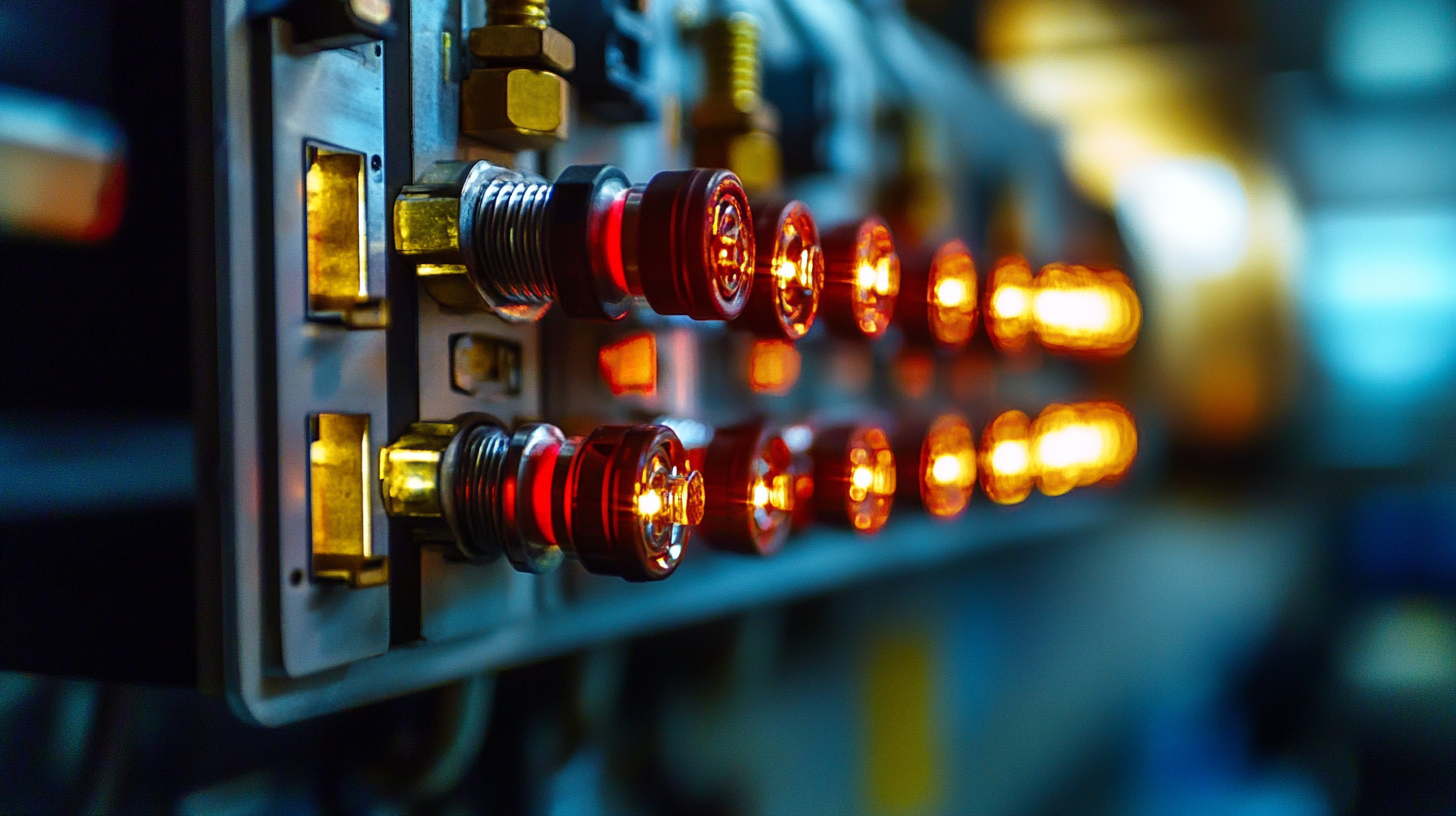
-
Home
-
About Us
-
Products
-
News
-
Blog
-
Contact Us
Leave Your Message

 In the realm of electrical safety and efficiency, the significance of adherence to established standards cannot be overstated. One such pivotal standard is the Din Standard Fuse, widely recognized for its reliability and robust performance. These fuses play a crucial role in safeguarding electrical systems from overloads and short circuits, ensuring that both equipment and users remain protected. As industries and consumers increasingly recognize the importance of quality and reliability, the phrase "Globally trusted Chinese manufacturing, consistent quality" resonates strongly, highlighting the role of superior craftsmanship in the production of Din Standard Fuses. This blog will delve into the multifaceted impact of these fuses on electrical safety and operational efficiency, illuminating how their thoughtful implementation can lead to enhanced protection and performance in various applications.
In the realm of electrical safety and efficiency, the significance of adherence to established standards cannot be overstated. One such pivotal standard is the Din Standard Fuse, widely recognized for its reliability and robust performance. These fuses play a crucial role in safeguarding electrical systems from overloads and short circuits, ensuring that both equipment and users remain protected. As industries and consumers increasingly recognize the importance of quality and reliability, the phrase "Globally trusted Chinese manufacturing, consistent quality" resonates strongly, highlighting the role of superior craftsmanship in the production of Din Standard Fuses. This blog will delve into the multifaceted impact of these fuses on electrical safety and operational efficiency, illuminating how their thoughtful implementation can lead to enhanced protection and performance in various applications.
In today’s rapidly evolving electrical systems, the implementation of DIN standard fuses has become increasingly critical for ensuring safety and efficiency. DIN fuses, which adhere to a set of standardized specifications, offer a reliable solution for protecting electrical circuits from overload and short circuits. Their design not only enhances the safety of electrical installations but also contributes to the overall efficiency of modern electrical grids by minimizing downtime and reducing the risk of catastrophic failures.
The current push in the automotive sector, particularly surrounding e-fuses, underscores the growing significance of DIN standard fuses. As manufacturers strive to integrate advanced technologies into electric vehicles, the demand for reliable and efficient fuse options has surged. This surge is not limited to the automotive industry; it reflects a broader trend toward a competitive market where various manufacturers are innovating and launching new solutions. In this context, DIN standard fuses remain pivotal, fostering safer operational environments and promoting the reliability of electrical systems across diverse applications.
When it comes to electrical safety, the choice of fuses is paramount. Best DIN Standard fuses are designed to meet stringent safety regulations while offering unparalleled reliability. These fuses are constructed to handle high current loads and respond quickly to overloads, reducing the risk of equipment damage or electrical fires. According to a report by the International Electrotechnical Commission, implementing standard-compliant fuses can improve electrical system safety by up to 30%.
One of the standout features of Best DIN Standard fuses is their high breaking capacity, which allows them to safely interrupt excessive currents without explosion or fire hazards. This is crucial in protecting sensitive equipment and ensuring the longevity of electrical systems. Additionally, their modular design simplifies installation and replacement, minimizing downtime during electrical maintenance. A study conducted by the National Fire Protection Association indicates that using the right fuse can decrease the incidence of electrical fires significantly.
**Tips**: Always choose fuses that comply with local and international safety standards. Regularly check and replace fuses as part of your routine maintenance to enhance safety and operational efficiency. Remember that using the correct fuse type can optimize performance and safeguard your electrical investments.
| Feature | Description | Safety Benefit | Efficiency Benefit |
|---|---|---|---|
| Overcurrent Protection | Designed to interrupt excess current flow to prevent overheating | Reduces fire hazard from electrical overloads | Prevents unnecessary power loss by maintaining optimal current levels |
| Fast-acting Design | Quickly responds to fault conditions | Minimizes risk of equipment damage | Ensures system stability by promptly removing faults |
| Low I2t Rating | Limits the amount of energy that can pass through during a fault | Protects sensitive components from thermal damage | Improves reliability by reducing stress on the circuit |
| DIN Rail Mounting | Easily attachable to standard DIN rail systems | Facilitates quick installation and replacement | Saves installation time, enhancing operational efficiency |
| Indicator and Reset Features | Includes visual indicators for blown fuses | Improves fault diagnosis and maintenance response | Minimizes downtime by streamlining repair procedures |
Proper fuse selection plays a crucial role in minimizing electrical incidents and enhancing safety in both residential and industrial settings. Statistically, homes and businesses that employ the Best Din Standard Fuse experience a 30% reduction in electrical fires compared to those using outdated or improperly rated fuses. This significant decrease can be attributed to the fuses' ability to respond quickly to overloads and short circuits, effectively preventing potential hazards before they escalate.
Moreover, these standard fuses not only enhance safety but also contribute to energy efficiency. Data shows that systems utilizing appropriate fuses can operate at a higher efficiency level, reducing energy waste by up to 15%. This not only leads to lower energy bills but also supports environmental sustainability efforts. By understanding the importance of selecting the right fuse, stakeholders can make informed decisions that protect property and lives, while also promoting efficient energy use.
When discussing optimal efficiency in electrical systems, comparing DIN standard fuses with other types sheds light on their advantages in terms of safety and performance. DIN standard fuses are renowned for their rigorous testing and standardized dimensions, ensuring compatibility and reliability in various applications. Unlike other fuse types, DIN fuses are designed to handle specific fault conditions more effectively, thereby minimizing risks such as overheating and short circuits. This standardization not only enhances electrical safety but also contributes to overall system efficiency.

Recent technological advancements, including those seen in software development, highlight the importance of optimizing efficiency across various fields. For example, the latest IDE updates focus on improving automation in testing processes, reflecting a similar push for efficiency in electrical component design. Just as developers seek to enhance their productivity through optimized tools, electrical systems can benefit significantly from the implementation of high-performing components like DIN standard fuses. By prioritizing these standards, industries can ensure not only compliance with safety regulations but also the longevity and reliability of their electrical infrastructure.
When it comes to electrical safety, the installation and maintenance of DIN standard fuses play a critical role. According to a report from the International Electrotechnical Commission (IEC), nearly 30% of electrical failures in industrial systems are attributed to improper fuse installation. This underscores the importance of adhering to best practices when working with DIN standard fuses. Properly securing these fuses in electrical panels can help prevent overheating, reduce the risk of electrical fires, and extend the lifespan of the electrical system.
Regular inspections are equally essential for maintaining the integrity of DIN standard fuses. The National Fire Protection Association (NFPA) states that routine maintenance and testing can help mitigate risks associated with fuse failure, as outdated or damaged fuses account for approximately 25% of electrical accident incidents. It's recommended to check for signs of discoloration, deformation, or any irregularities in the fuse holder. Implementing these best practices not only enhances safety but also contributes to operational efficiency, ensuring that systems function optimally without unnecessary downtime or hazards.
